
DevSkiller Top IT Skills Report 2022: Tech talent hiring insights
Foreword
Much like 2020 before it, 2021 has continued to present challenges for the technical hiring industry. With technological development continuing to outpace the number of developers, demand and salaries are increasing exponentially.
As ever, at DevSkiller our mission is to help companies to navigate the minefield that is technical recruitment. To provide our clients with the means and tools to attract the best tech talent and to select the best candidates available, effectively.
In the 2022 edition of the DevSkiller Top IT Skills Report: Tech talent hiring insights, we lay out some of the emerging trends of the past year, as well as our predictions for the year to come. We also discuss the technologies that made the most headway over the past year.
This report was designed to offer you guidance and clear advice in your technical recruitment efforts. I hope you can gain some valuable insight from the data we have collected over the past twelve months as you push forward in 2022.
I wish you all the best in the year ahead.
Jakub Kubrynski
DevSkiller CEO
Table of contents
Want a copy to take home?
Download the pdf version here!
DOWNLOAD NOWTech talent patterns and trends in 2021
The pandemic of 2020 caused unprecedented disruption to the world. In 2021, the dust had finally started to settle and the figures emerged of the real effect on life, technology and business in the “new normal.” These changes and the challenges that came with them certainly make for interesting reading – not least in the world of technical recruitment.
Dubbed the ‘Great Resignation,’ according to the latest JOLTS report (Job Openings and Labor Turnover Survey), 4.4 million Americans left their jobs in September 2021, compared to 2.1 million per month at the start of 2020. September being the sixth month in a row that the figures had continued to rise.

The figure for November itself, showed a record 4.5million workers quitting their jobs. About 3% of the total workforce.
The reason for such a mass walkout was put down to people no longer wanting to work, so-called, “unreliable” positions that may leave them without a wage (or with a relatively small one) should another lockdown occur.
But how has all of this affected the technical hiring industry, especially with so many of its workers operating remotely?
The globalized IT workforce
In recent years, demand for developers and engineers has soared in most areas of the technology industry. With more technical positions available now than ever before, developers can demand huge salaries. In particularly niche roles, DevOps for instance, wages have soared, as the amount of qualified candidates remains scarce. But the pandemic has had a huge effect on this too.
For the first time ever, remote work is not only being talked about as a serious long-term option, but its popularity has also exponentially increased, due to the extremely rare working conditions brought about by the outbreak of COVID-19. This trend has had a knock-on effect on the tech talent landscape. Employers no longer need to search for qualified candidates ‘in their own backyard’.
With online technical assessments, video interviews, and the ability to hold a conference call from one’s own home, technical recruiters have started to search for developers further afield, and with surprising results. There has been an increase in the number of western tech companies, making hires in countries that before, were not on their radar.
Something that mobile technology giant Orange predicted all the way back in September 2020:
The remote working trend triggered during the COVID-19 pandemic could become a huge opportunity for workers in developing countries across the Middle East and Africa.
Although it is the countries across the Middle East and Northern Africa (MENA) that have been hit by some of the worst poverty caused by the pandemic, those who are able to get regular internet access can be amongst the lucky few who are part of a digital transformation in the area.
Global digital transformation
The global lockdown has only succeeded in further highlighting the need for digital transformation around the world, while the means to bring about such transformation are often still lagging in many areas (such as MENA). 2021 did however bring to the forefront various general areas of digital transformation in companies across the world.
Agile processes
The shift to digitalization has meant that companies have had to align their processes to keep up with the changing business world. Agile practices include iterative development (breaking larger projects down into small chunks), daily meetings, and continuous employee feedback.
Low-code development
Low-code development involves building applications and processes in a way that requires very little coding. The approach uses visual interfaces rather than complex programming languages. Although not a new term, the approach did gain a lot of traction with companies in 2021.
Cloud integration
Moving to the cloud for many companies became a priority in 2021, highlighted by the fact that many enterprises were suddenly divided into home offices spread across huge areas. The physical office space has been made somewhat redundant for many companies and the need to have all data and processes backed up digitally has become a priority.
Upcoming technologies and in-demand skills
DevOps
In many ways, 2021 has been the year of DevOps.
In 2021 DevOps has gone from a technical buzzword to a role many companies are suddenly scrambling to try to fill in order to stay ahead of the game.
DevOps is more of an umbrella term that encompasses several technical aspects. A whole culture that is implemented into working environments to ensure processes are as efficient and streamlined as possible. The role requires a real technical all-rounder. Someone with a varied skill set and the ability to constantly update processes and tweak systems to get the best results.
DevOps practitioners have become some of the most sought-after personnel in 2021 and it’s proven to be a tricky position to fill. DevOps practitioners are some of the most highly paid as a result. In fact, they are leading the way in the digital transformation that has been accelerated by the pandemic.
As the BMC DevOps Salary Trends report states:
Overall, the global pandemic proved to push businesses to further develop and embrace their digital transformation initiatives, launching tech companies, and salaries, into the stratosphere. As organizations continue to depend on their digital technologies, the practitioners that make them happen will only further become more crucial, a benefit for anyone seeking a career in DevOps.
AI and Machine Learning
It’s not only DevOps that has seen exponential growth in 2021, positions in AI and machine learning have also seen a huge increase. As the technology around these fields grows more sophisticated, so does the interest in each prospective field.
In the 2021 McKinsey global survey on AI, 56% of respondents listed, “AI adoption in at least one function, up from 50% in 2020.”
General machine learning is also on the rise. With big-name players in the tech world incorporating machine learning into their everyday processes.
Average software developer salaries in 2021
Software developer salaries continue to be amongst the most well-paid jobs in 2021.
Below you can find a comparison list of 10 countries’ average salaries for a software developer (when converted to USD):
Country | Average annual salary (USD) |
|---|---|
| Switzerland | $89,918 |
| United States | $73,099 |
| Denmark | $67,854 |
| Norway | $62,080 |
| Germany | $56,832 |
| Canada | $53,136 |
| Australia | $50,808 |
| Finland | $46,432 |
| Netherlands | $43,239 |
| France | $41,727 |
| United Kingdom | $41,479 |
The values seen are valid at the time of December 2021. Most software developer salaries worldwide are relatively comparable to those of 2021. There is a slight decrease in the top salary (Switzerland) from 95k in 2020 to 89k in 2021.
For more job-specific salary information visit our software developer salaries page. We regularly update this data to keep our readers informed of any movement in salary for various tech roles.
IT skills insights and trends
Java and SQL are the most popular IT skills tested (19%)
Java and SQL are tied for first place as the most in-demand IT skills for 2022. The two were each seen in 19% of test invites.

Why don’t the percentages add up to 100%?
This year, we’ve witnessed some dramatic changes in testing behavior on DevSkiller TalentScore. In the past 12 months, there has been a more balanced spread in the popularity of programming languages compared with previous years. This year, JavaScript slipped to third position, down from first position in last year’s report. What is more telling is that JavaScript was seen in 43% of all test invites in 2020 compared to 18% of test invites in the 2022 report.
Rounding out the top five were Python (9%) and PHP (6%), knocking out .NET/C# and CSS/HTML respectively. The rise of Python is no surprise given its popularity for newcomers to coding and its application in rapidly developing areas like Data Science, AI, and machine learning. This sentiment is echoed in the 2021 Stack Overflow Developer Survey where Python leapfrogged SQL as the third most popular language in their annual survey.
Data Science was the fastest growing IT skill in 2021 (295% growth)
In this year’s report we decided to not only share the most popular IT skills but also the fastest growing IT skills that our customers were testing for in 2021. This year, Data Science took out the top spot with a 295% growth in popularity year over year.
The rise in popularity of Data Science comes as little surprise given how valuable data has become to companies across the globe. Companies are spending big on building the right teams of data scientists who can help them grow more dynamically.
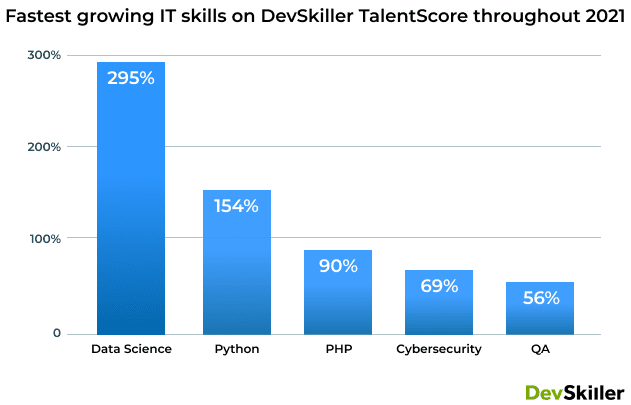
Python (154%), PHP (90%), Cybersecurity (69%), and QA (56%) rounded out the top five each with their respective year over year growth. The occurrence of Cybersecurity in the top five should be of no surprise given the rapid rate at which technology has developed in the past 12 months. The COVID-19 pandemic forced many companies to rapidly digitalize their workflows which has brought about constant new threats that need to be addressed by qualified security experts.
JavaScript and HTML are the most commonly tested IT skills together (13.8%)
In previous years, we analyzed the most commonly paired programming languages based on TalentScore test invitations. This year, instead of only focusing on programming languages we decided to include all of the technologies that we test on our platform. This includes frameworks, libraries, tools, and many other resources that we have available for technical screening purposes.
The top 10 commonly paired IT skills tested on TalentScore are as follows; JavaScript & HTML, JavaScript & TypeScript, JavaScript & CSS, JavaScript & Angular, CSS & HTML, Linux & DevOps, Java & Spring Boot, TypeScript & Angular, JavaScript & SQL,
and Java & Hibernate
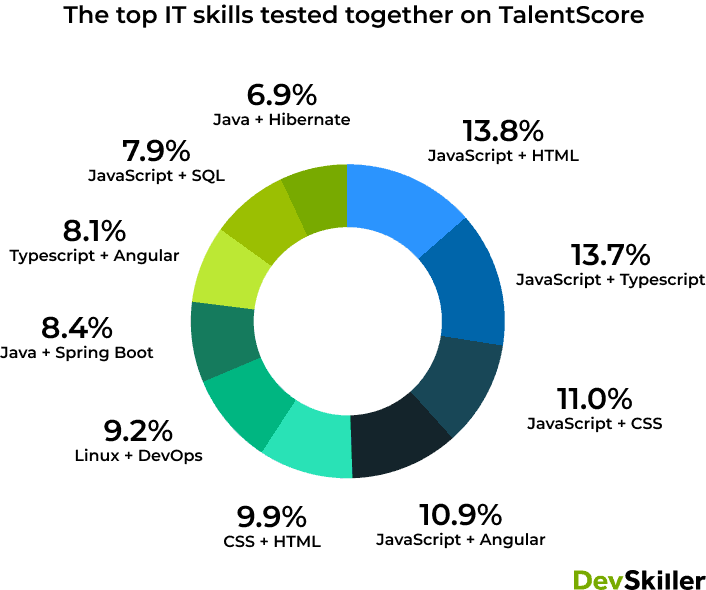
Our findings indicate that companies are looking for developers that are knowledgeable in not only the programming language itself but other key components of the tech stack. Take Java & Spring Boot as an example. Spring Boot is often the framework of choice for many Java applications, so it is little surprise to see companies testing for both technologies within a single test invitation. The same can be said of Linux & DevOps. It would be rare to find a DevOps engineer who doesn’t have at least a basic understanding of the Linux operating system.
The other interesting finding from our research is the continued rise to prominence of TypeScript. TypeScript enables more robust software that is easily deployable with a regular JavaScript application. As a result, companies that are hiring frontend developers need to be able to verify their skills in both JavaScript and TypeScript.
React, Spring, .NET framework, MySQL, HTML, Python 3.x, PHP 7, Linux, Data Analysis are the most popular technologies in their respective tech stacks
Through the power of RealLifeTesting™, we test not only a developer’s knowledge of a given programming language but also their ability to understand the varying resources and tools of the given tech stack that they’ll be using. In this section, we’ve highlighted the most popular IT skills, resources, and technologies of the nine most popular tech stacks on DevSkiller TalentScore.
The most popular tech stacks we test
| 1. React | 26.32% |
| 2. TypeScript | 19.21% |
| 3. ES6 | 16.25% |
| 4. Angular | 14.68% |
| 5. Node.js | 12.10% |

| 1. Spring | 31.80% |
| 2. Spring Boot | 25.68% |
| 3. Hibernate | 16.67% |
| 4. Maven | 10.20% |
| 5. Gradle | 9.86% |

| 1. ASP.NET | 39.76% |
| 2. .NET Framework | 18.39% |
| 3. .NET Core | 14.50% |
| 4. .NET 5 | 10.31% |
| 5. Entity Framework | 4.93% |

| 1. MySQL | 39.68% |
| 2. MSSQL | 18.12% |
| 3. PostgreSQL | 16.40% |
| 4. MongoDB | 8.60% |
| 5. NoSQL | 5.69% |

| 1. Python 3.x | 59.70% |
| 2. Data Analysis | 14.35% |
| 3. Django | 7.81% |
| 4. Pandas | 7.38% |
| 5. NumPy | 3.16%/td> |

| 1. PHP 7 | 32.79% |
| 2. Symfony | 20.77% |
| 3. Laravel | 18.03% |
| 4. WordPress | 13.11% |
| 5. Doctrine | 10.38% |

| 1. HTML/CSS | 54.69% |
| 2. Node.js | 26.73% |
| 3. WCAG 2.0 | 9.18% |
| 4. Sass | 6.53% |
| 5. LESS | 2.86% |
| 1. Data analysis | 32.69% |
| 2. Macine Learning | 24.04% |
| 3. Pandas | 16.83% |
| 4. PySpark | 10.58% |
| 5. Big Data | 9.68% |

| 1. Linux | 46.46% |
| 2. Docker | 17.33% |
| 3. Bash | 12.79% |
| 4. Kubernetes | 10.29% |
| 5. AWS | 9.70% |

React (26.32%) leads the way as the most popular technology within the JavaScript tech stack
React leads the way for the third year running as the most popular technology within the JavaScript tech stack. React has been the preferred choice for JavaScript applications for some time given its ability to help developers build dynamic web applications with terrific speed. The popularity of React amongst our customers is echoed in the 2021 Stack Overflow Developer Survey where it too came in first place for the most common web frameworks amongst their respondents. Rounding out the top five were TypeScript (19.21%), ES6 (16.25%), Angular (14.68%), and Node.js (12.10%).

Spring (31.80%) holds onto the top spot in the Java tech stack
For the third year running, Spring takes first place as the most popular technology within the Java tech stack. Spring Boot (25.68%) continues to make up ground on Spring with a 7.18% increase in the past 12 months. It appears that it won’t be long before Spring Boot will grab top honors given its ease of use and popularity amongst the Java community. Hibernate (16.67%), Maven (10.20%), and Gradle (9.86%) rounded out the top five, respectively.

PHP 7 (32.79%) was the most popular technology within the PHP tech stack
Similarly to Python 3.x, we have differentiated PHP 7 to demonstrate which version of PHP that companies are testing their developer candidates in. This year, PHP 7 was seen in 34.48% of all PHP based coding tests. Symfony (20.77%) held onto second position this year while Laravel (18.03%) slipped to third position this year. WordPress (13.11%) and Doctrine (10.38%) rounded out the top five for the PHP tech stack in 2021.

ASP.NET was seen in 39.76% of .NET/C# coding tests
ASP.NET remains the most popular technology tested within the .NET/C# tech stack. The continued prevalence of the ASP.NET web app framework in TalentScore tests represents just how important web development is in the .NET/C# tech stack. .NET Framework (18.39%) and .NET Core (14.50%) came in second and third positions respectively, while .NET 5 (10.31%) and Entity Framework (4.93%) rounded out the top five.

MySQL (39.68%) was the most tested database technology in 2021
MySQL (39.68%) is the most popular database management system despite losing some ground from last year (53%). MSSQL (18.12%) came in second position and PostgreSQL came in third with 16.40%. Rounding out the top five were MongoDB (8.60%) and NoSQL (5.69%). Although MongoDB is a part of the NoSQL family we decided to separate the two to present how popular the MongoDB database management program is amongst companies.

HTML/CSS (54.69%) were seen in more than half of all web development coding tests
It should come as no surprise that HTML and CSS were the most popular web development technologies tested in 2021. The pair have been stalwarts in frontend development for many years and so their place is certainly justified. NodeJS (26.73%) came in second place while WCAG 2.0 (9.18%) finished in third position. The remainder of the top five consisted of Sass (6.53%) and LESS (2.86%).

Python 3.x (59.70%) retains the top spot in the Python tech stack
As we alluded to last year, we differentiate between older versions because Python 2.x was discontinued last year. Despite losing some ground from last year, Python 3.x retains the top spot within the Python tech stack for 2021. Data analysis (14.35%) also held onto its position as did Django (7.81%). Pandas (7.38%) and NumPy (3.16%) completed the top five in 2021.
Data analysis was seen in 32.69% of Data Science coding tests
Given how popular Data Science has become to companies across the globe we have decided to dedicate an entirely new section to this year’s report. In 2021, Data Analysis (32.69%) was the most popularly tested skill within Data Science coding tests. The continued importance of Machine learning (24.04%) to business objectives was reflected by our customers where it came a close second. Pandas (16.83%), PySpark (10.58%), and NumPy (9.68%) rounded out the remainder of the top five.

Linux (46.46%) takes the top spot within the DevOps tech stack
Linux was seen in 46.46% of DevOps coding tests in the past twelve months. We decided to include the popular operating system this year to demonstrate its importance for creating dynamic development processes for DevOps teams. Docker (17.33%) dropped to second position from first position last year while Bash was seen in 12.79% of DevOps coding tests. Rounding out the top five was Kubernetes (10.29%) and AWS (9.70%).
Technical candidate insights and behavior
Candidates wait on average 2 days and 16 hours to take a coding test
The average wait time between a candidate receiving a coding test invitation and taking the test is 2 days and 16 hours. This finding represents a slight increase compared to last year’s report (2 days and 13 hours). Despite the increase, candidates are still acting rather promptly to complete the coding test invitation sent to them.
The increase is likely caused by the fact that because developers are in such high demand, many are fielding more than one offer at once. Another trend that we have witnessed is developers testing the job market by applying for multiple open positions while still working in their current role. This trend could be another reason for extended response times to coding test invitations.
Coding tests sent on a Wednesday get the fastest response time for the third consecutive year
For three consecutive years, coding tests sent on a Wednesday get the fastest responses. Once again, the average response time has climbed slightly higher across the board.
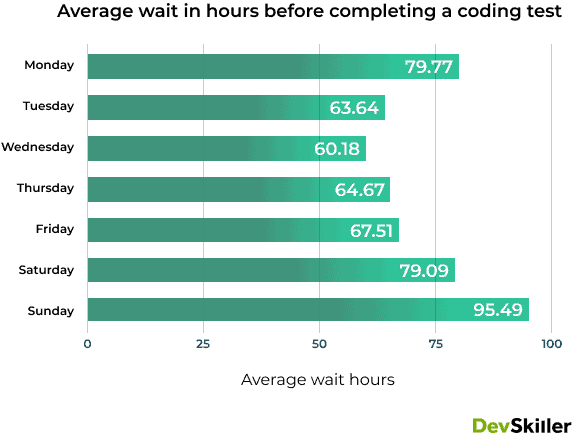
This year, we decided to include data on candidate behavior over the weekend. Unsurprisingly, coding tests sent on either a Saturday or Sunday have much longer response times than those sent on weekdays.
Candidates wait on average 4 days and 11 hours to take Java coding tests
This year, we have included a breakdown on the time taken to complete coding tests based on the technology tested. In the graph above, we have outlined the top ten technologies that candidates took the lThis year, we have included a breakdown on the time taken to complete coding tests based on the technology tested. In the graphic below, we have outlined the top ten technologies that candidates took the longest to open and complete. In the past twelve months, Java coding tests took the longest with an average of 4 days and 11 hours. In second place was SQL with an average of 3 days and 6 hours.
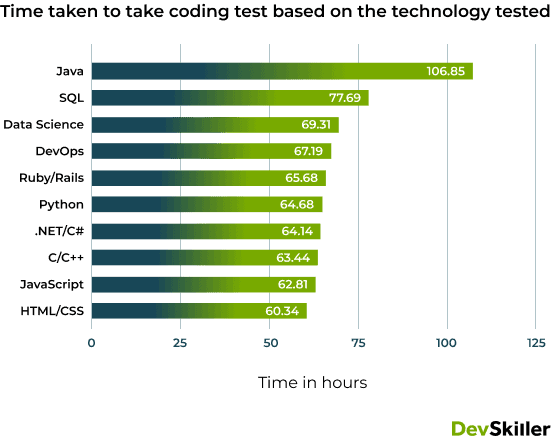
This finding should come as little surprise given how popular the two IT skills were amongst companies in 2021 (see section 1.1). Technical candidates who possess these skills are in great demand and are likely fielding multiple offers at once which is likely the reason for the slow response time.
On the other end of the spectrum, candidates taking Blockchain coding tests, consisting primarily of Solidity (the primary language for Ethereum) took only 10 hours to respond to their test invitation.
Tech recruitment insights
There were 1587 new recruitment tasks added to TalentScore in 2021
In this year’s report, we have included data on the fastest-growing technologies on TalentScore. At DevSkiller, we pay close attention to the needs of companies in their search for the next generation of great developers. We strive to provide recruitment tasks that not only challenge developers but provide clarity on the candidate’s overall role fit during these hiring decisions.
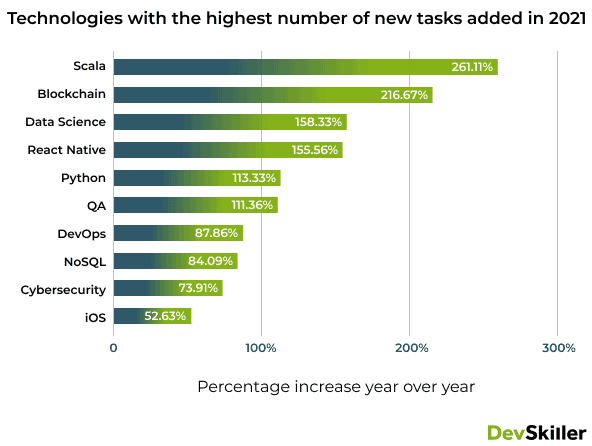
In 2021, the team at DevSkiller added 1587 new recruitment tasks to our technical screening solution, TalentScore. The fastest growing technologies, based on the number of new tasks added in 2021, were; Scala (261.11%), Blockchain (216.67%), Data Science (158.83%), React Native (155.56%), Python (113.33%), QA (111.36%), DevOps (87.86%), NoSQL (84.09%), Cybersecurity (73.91%), and iOS (52.63%).
At DevSkiller, we keep our ears to the ground to provide our customers with recruitment tasks that match the trends of the global technology industry. Trends such as the rise in popularity of Crypto, the shift to remote work, and the value of data prompted us to increase our content for Blockchain, DevOps, and Data Science. We will continue to follow these global trends to provide cutting edge assessments for companies all over the world.
40.1% of our customers were testing for junior developers in 2021
The great thing about TalentScore coding tests is that it gives our customers the flexibility to assess developers of varying levels of seniority. In fact, we have over 350 pre-defined coding tests available for junior, middle and senior developers.

In the past 12 months, 40% of coding test invitations were for junior developers, 23.4% were for middle developers, and 36.6% for senior developers and engineers.
Companies tested for all levels of JavaScript developers in 2021
Software development continues to be a promising career for many new developers who are entering the workforce. The potential that relatively inexperienced developers offer is highly desirable for companies because they can be groomed within a particular company structure and culture. In the tech stacks we featured below, junior developers were again the most highly sought after in 2021. Leading the way were junior Python developers (54.78%) and junior Data Scientists (45.45%).
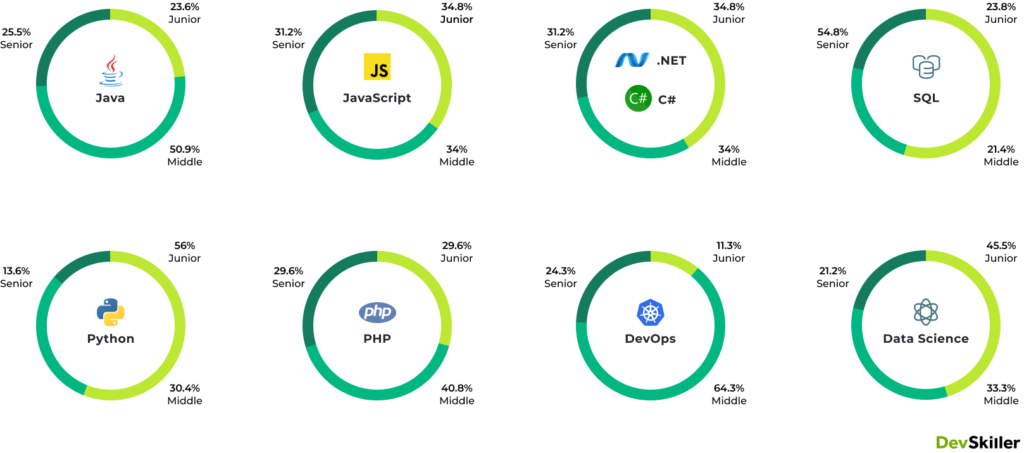
Although junior developer tests were the outright winner for 2021, many companies were testing for mid and senior level developers. TalentScore coding tests provide our customers with the platform to assess for more senior positions in addition to these less experienced roles. Most notably JavaScript with 34.8% of companies testing for senior roles and .NET/C# with an almost perfect split between junior, middle, and senior developer testing.
Our platform provides a world class candidate experience for developers of all levels of seniority. In 2021, we added state of the art web browser IDEs from JetBrains for Java, Python, Android, and JavaScript coding tasks and we’ll be launching more in-browser IDEs in 2022. This incredible feature allows developers to start coding in their preferred Integrated Development Environment (IDE) as soon as they open the test invitation.
We helped thousands of people get tech recruitment certified!
The DevSkiller Tech Recruitment Certification course was once again popular amongst tech recruiters in 2021. In the past 12 months, we saw a 36% drop off in the total number of tech recruitment certifications completed versus that of the previous year. In 2020, we saw an unprecedented spike in the number of recruiters who got certified due to the COVID-19 outbreak and subsequent lockdown.

In total:
- 61% of recruiters passed the certification course on the first try
- 26.61% on the second try
- 12.11% of recruiters took three tries to pass the course.
We also have great news! We will be publishing a freshly updated version of our Tech Recruitment Certification Course in Q1 of 2022. Keep an eye on this space and get certified with our brand new course.
Geo trends in tech talent sourcing
Take a look at the most popular IT skills in your country
In section 1.1 of this report we outlined the most popular IT skills tested on our developer screening platform TalentScore. In this section, we have dug deeper into our data to provide you with the top three IT skills tested by country, based on the total number of test invitations sent.
Click for top technologies

2022 - 4.1
As you can see, Java and SQL feature prominently which is little surprise given that the two technologies were each seen in 19% of all TalentScore coding test invitations in 2021. Take a look and see which IT skills were popular in your country over the past twelve months.
International hiring was the biggest trend of 2021
One of the biggest trends that we’ve seen over the past twelve months is how companies are looking beyond their own borders to find technical talent. Ever since the outset of the COVID-19 pandemic and subsequent shift to remote work, companies have had more flexibility about where they source and hire developers.
Click for top countries

2022 - 4.2
Companies from Switzerland, Denmark, Kuwait, Malta, Bulgaria, and Austria all saw their international hiring
An added dimension to this trend is the fact that local companies are searching for developers from nations that are within close proximity to their own. This hiring policy is likely due to the fact that developers from neighboring countries can still work similar hours to that of the remaining local workforce. For instance, Brazilian, Argentinian, and Columbian developers were within the top five most sought after candidates for US companies. By the same token, German companies relied on the services of developers from Ukraine, Poland and Turkey.
If there is one thing that the COVID-19 pandemic has shown us over the past two years is that remote work is no longer a trend, but here to stay. Although there will likely be a return to the office in some format over the next twelve months, fully remote and hybrid working environments will continue for the years to come.
Local companies are seeking technical talent from their neighboring nations
As we outlined in section 4.2, international hiring was one of the biggest trends of 2021. Many companies are now providing fully remote positions to expand the talent pool from which they hire developers. This flexibility provides companies with an entirely new talent pool of developers that can help them achieve their company goals.
Hover over a country to see their score

2022 - 4.3
Companies from Switzerland, Denmark, Kuwait, Malta, Bulgaria, and Austria all saw their international hiring percentage exceed 90%. Most astounding was the sheer increase of international hiring from last year. Companies from the United Kingdom (85.28%) and the United States (88.18%) saw increases of 87% and 71% respectively. This trend of international hiring is something we predict to continue in 2022 as more companies offer fully remote positions.
Candidates from Belgium scored the highest on coding tests
Last year, we analyzed the highest scoring candidates by analyzing the 90th percentile – which demonstrated the result that only the top 10% of all candidates in a given country scored higher than. In other words, only 10% of developers from the given country scored higher in their coding tests than the results we presented. This year, we returned to the mean average score to provide you with the highest scoring candidates.

This year, based on mean score, Belgian developers scored the highest on TalentScore coding tests with an average score of 85. Developers from Chile came in second with 75 while Italian developers scored an average of 64 to take third place. Rounding out the top five were developers from the Philippines and Poland, each with an average score of 62.
Recommendation for Tech Talent Recruiters
We’ve concluded with our tech talent hiring insights from the past twelve months. It is now time to set our predictions for the year ahead.
Further disruption to the technical hiring industry is almost inevitable due to the ongoing; COVID-19 pandemic. Unfortunately for many technical recruiters, the difficulties in finding talent in 2021 could yet spill over into 2022. As Glassdoor described in their predictions for 2022:
Employers may be ready to write off the tight 2021 labor market as a pandemic-era anomaly, but they shouldn’t. Instead, 2021 should be a template for what to expect in 2022.
The technical hiring trends in 2022 will likely rely largely on the country in question. Some areas of the world are recovering quicker than others from the pandemic of 2020 and, so far at least, have not been as affected by the latest outbreaks. This will mean some countries can get a head start in their recovery
Remote hiring challenges
Since the pandemic, remote-hiring has become not only commonplace but essential for many companies in the tech-hiring industry.
As demand for tech talent increases, it outpaces the number of candidates to choose from. The search for the right candidate stretches further and further and the remote hiring trend creates its own set of problems
As an example, the argument on whether or not to adjust employee salaries to be relative to the country in which the employee lives. Facebook (Meta) for instance, announced in 2020 that it would adjust salaries in the future for workers depending on living area. Whereas in 2021, tech giants like Reddit and Spotify stated that employees would be paid the same regardless of location.
To continue to attract the best talent remotely, offering a competitive salary that matches that of even a neighboring country’s economy, might be a great way to attract the best candidates. But it won’t always be practical, particularly not for smaller tech companies. As Glassdoor stated in their 2022 workplace trends report.
The labor market could experience…local employers having to pay more to compete with major companies coming in to scoop up local talent as remote workers.
The pandemic has also made it harder than ever for employees to feel personally invested in their workplace or company brand. The ‘water-cooler’ workplace camaraderie that was once part and parcel of many jobs in the technical hiring sector, has been hit hard by remote work. With that, goes the sense of loyalty that many employees feel towards their employers. To overcome this, more than ever, companies will have to offer not only bonuses but competitive year-round salaries. Hiring managers will also have to come up with more creative ways to help their company’s brand to stand out and to offer candidates something unique.
COVID-19 burnout
The long-term effects of the pandemic in technical hiring will only start to be realized in the year to come. After all, the shift in working habits for most has been huge over the past couple of years. The long-term psychological effects of no longer going to the office and being restricted to one’s own house might be still to play out.
As Protocol put it when discussing Glassdoor’s predictions for 2022:
There’s significantly more chatter on Glassdoor about mental health and burnout. Mentions of those two terms in Glassdoor reviews have more than doubled during the course of the pandemic.
More than ever, companies are doing all they can to keep up employee morale and job satisfaction. Not easy when you don’t even meet much of your workforce day-to-day. Invariably the companies that can come up with the most creative solutions for remote-work employee satisfaction, will be the ones who not only attract but also retain the best tech talent going forward.
The methodology we used for this study
The data we used for this study came from a 365-day snapshot of users on our platform between December 1st, 2020 through December 1st, 2021. The insights are based on coding tests taken through the DevSkiller platform by candidates in 156 countries. All data presented here is generic aggregated demographic information. It is not linked to any specific information regarding certain candidates or companies.
If you have any questions or comments regarding the report, you can get in touch with us by emailing research@devskiller.com.
*In section 1.1 the percentages don’t add up to 100%. Why is that?
Section 1.1 A DevSkiller test can include multiple technologies. For instance, you could have a test in Java and a test in Java+SQL. In this sample, 100% of the tests test Java and 50% of the tests test SQL. In the same way, the percentage in the chart refers to when the technology is tested in any test.